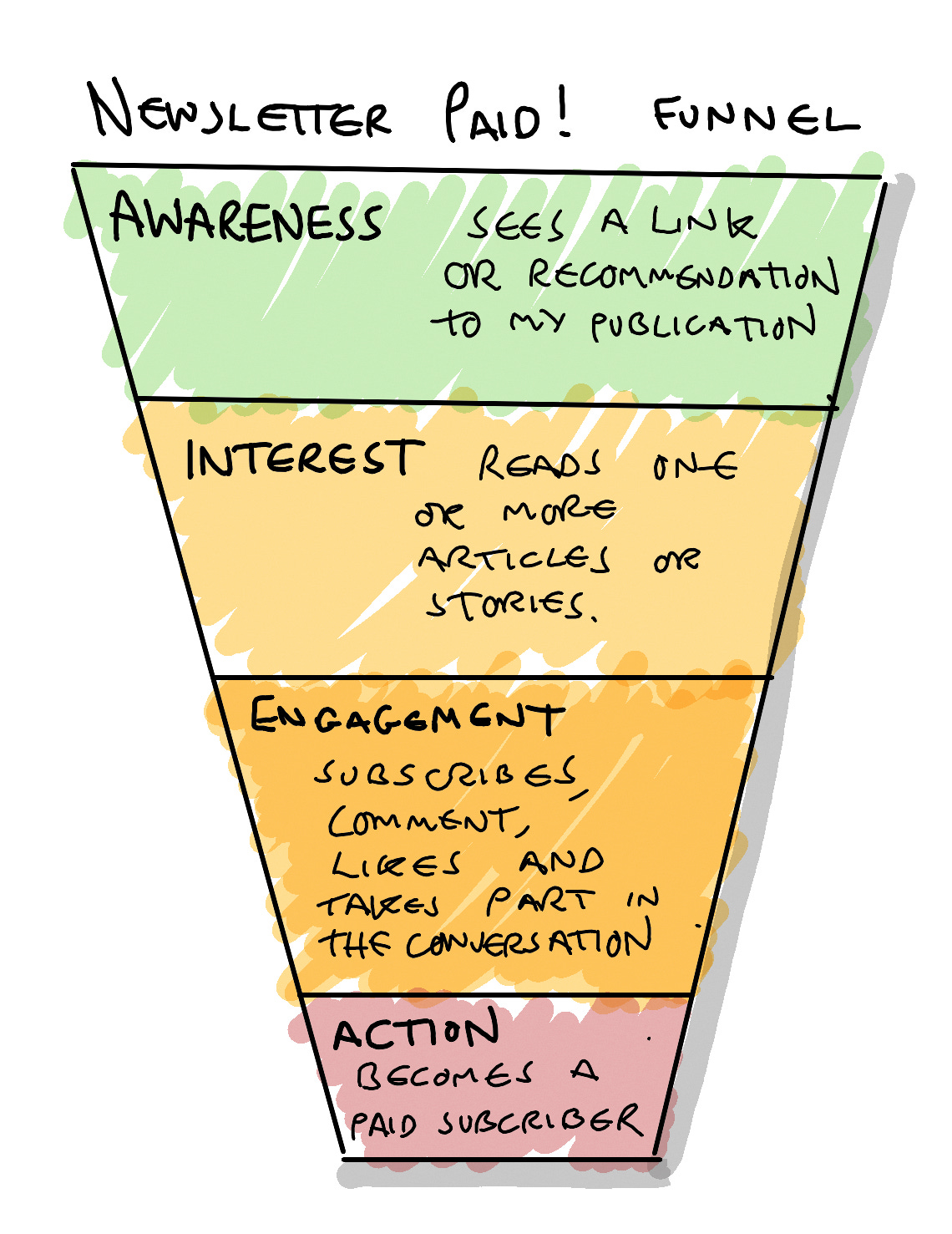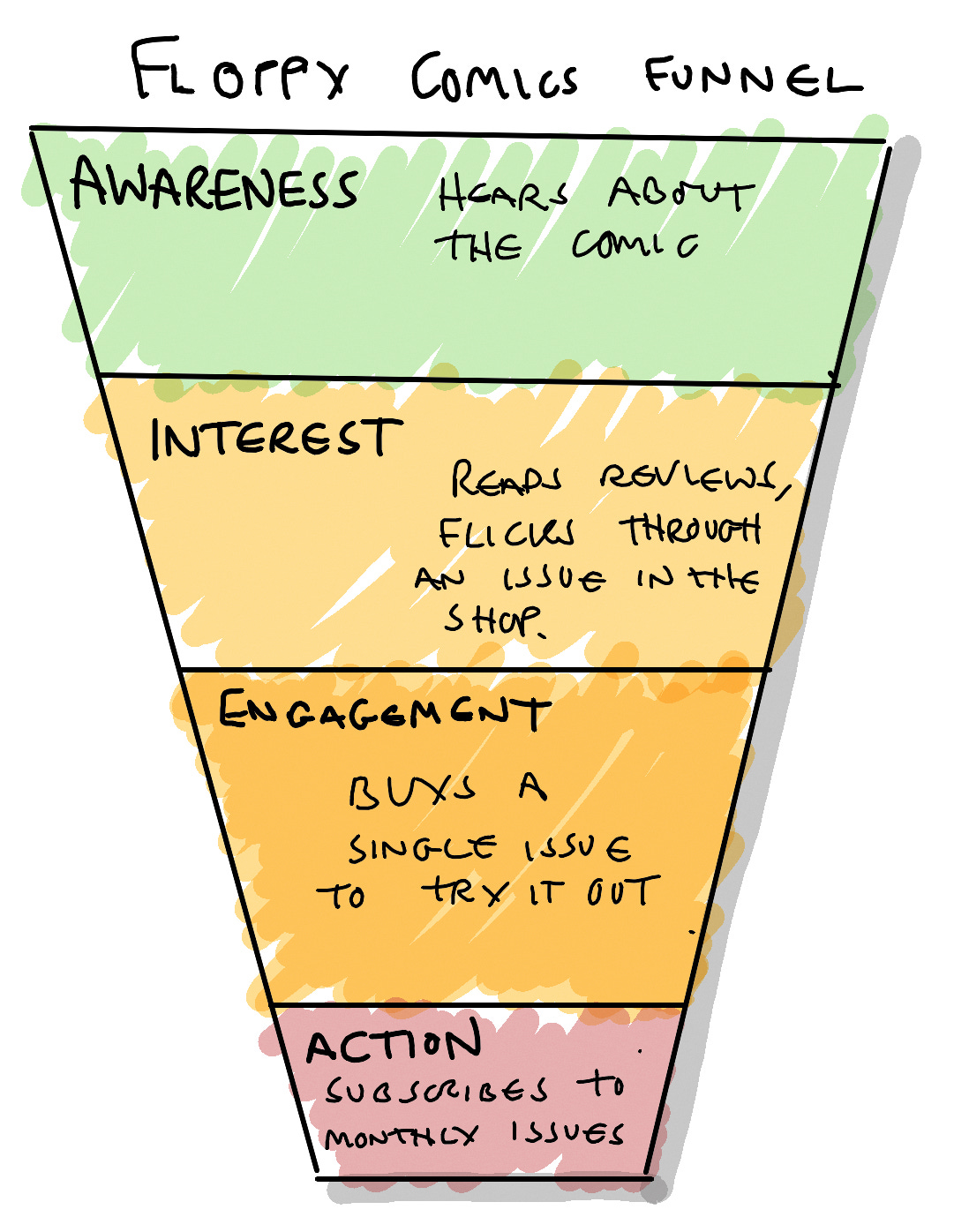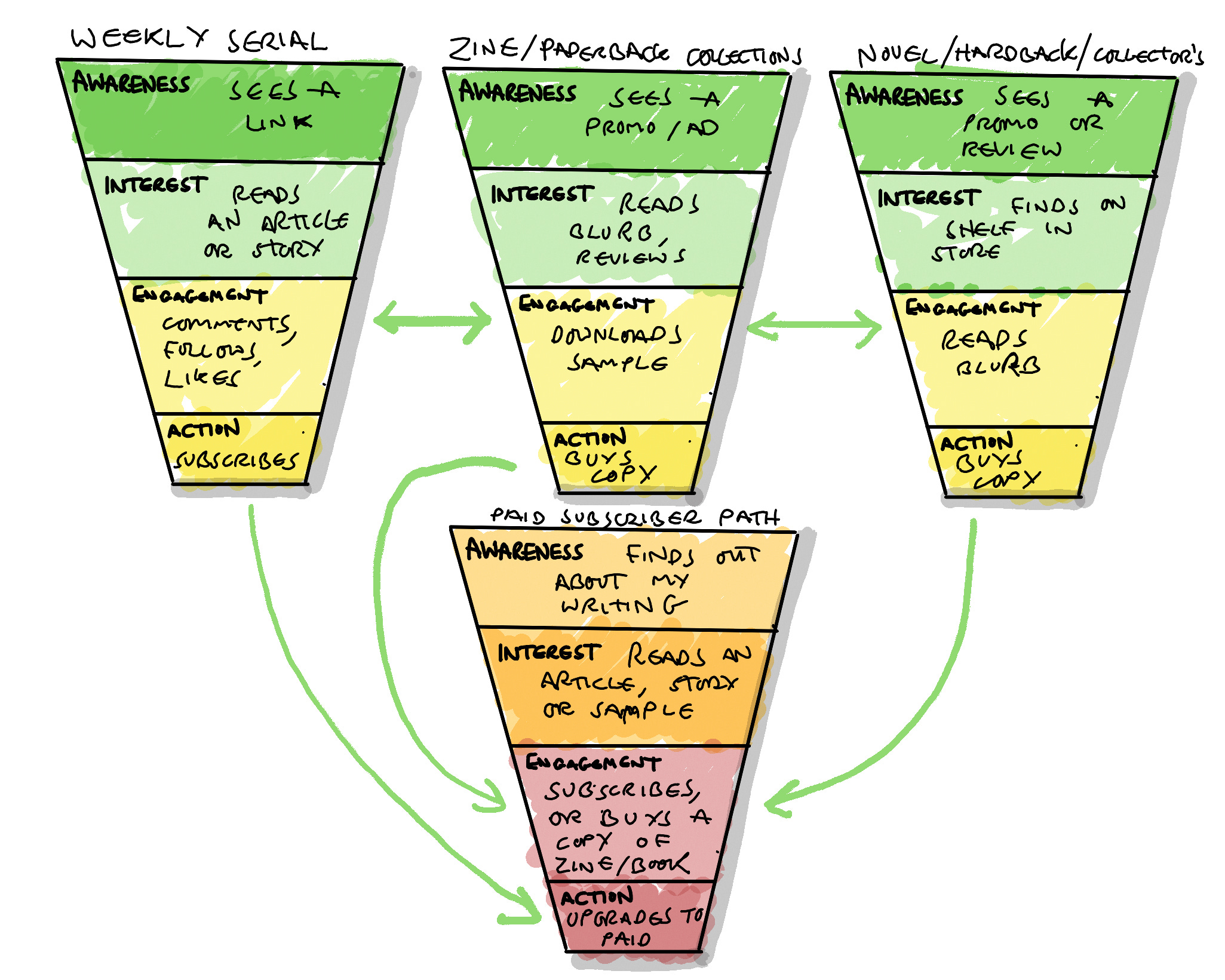Figuring out the serial publishing model
(and how I got it wrong)
There are many ways of publishing your work, and we’re living in something of a golden age for author choice.
My chosen route is to send out chapters in serial form, and I’m now fairly certain that for the last four years I’ve been doing it wrong.
In 2021 I started publishing Tales from the Triverse, which is now nearing completion. It’s a huge thing, at over 350k words. I’ve been head-down for that entire time, making sure I get the story out into the world to the best of my ability. While it’s gone well, and I’m pleased with the book and its reception, I’m starting to think I’ve missed several opportunities.
Publishing a weekly online serial has benefits:
It builds a long-term readership
The time investment makes readers really care about the story and characters
The regular pace helps with being a consistently productive writer
But also some challenges:
The slow delivery will frustrate many readers
It takes a long time to publish the entire story
It’s difficult for readers to get on board mid-way through
Navigating the book online can be frustrating
Some readers simply don’t like reading on a screen
Some of this I identified fairly early and took steps to address. You can see me trying to work it out back in 2022:
I did some of those things: an audiobook version of chapters, and an ebook compilation (though that’s an exclusive for paid subscribers).
An important UX tweak was adding an index/introductory post, to help new readers find their way in. Especially if you’re publishing on Substack, which doesn’t natively support fiction serials, it’s a critical asset:
Despite all of that, I’ve missed several tricks. This post is me reflecting on a decade of writing online serials, and four years publishing on Substack, in the hope of doing it better next time. I’m trying to come up with a better model, and I’d really value your feedback, whether that’s as a writer, a reader, or a bit of both.
Let’s talk about funnels
In marketing, we’re obsessed with funnels. The notion being that if you’re selling an expensive product, you can’t generally expect new customers to come along and immediately buy it. They’re going to have to think about it, or be convinced.
This can sometimes be brute-forced through aggressive marketing spend (ads, basically), but it’s often more effective over a longer time period to instead create a funnel. It’s about creating multiple touchpoints at which a customer can jump aboard, and acknowledging that different people have specific interests and needs.
Here’s the classic setup:
At the top you have people first becoming aware of your product. They know it exists, but they’re not going to do anything about it. If you can move them from there to the next stage down, ‘Interest’, it means they’ve not only heard of your product, but it’s stayed in their mind. Maybe they’re going to look up some reviews, or ask friends about it.
Shift people to ‘Engagement’ and you’ve got the beginnings of fans. These are people who go out of their way to keep an eye on your product. Pricing, new versions, hunting down reviews and analysis.
The ‘Action’ stage is when someone finally decides to make a decision and go for it: they’re buying your product!
You can, of course, define these stages in all sorts of ways depending on the context of what you’re doing. The core point is to understand that it’s pretty easy to get people into the top stage: that’s why it’s an inverted pyramid shape, where you have lots of people initially, but far fewer people by the time you get down to the bottom.
Here’s a version of the funnel applied to a traditionally published book:
Applying this to an online serial is a fun experiment, especially in the context of a newsletter with an optional patronage model like this one. Here’s one way you could do it, in which a subscription is the main action being coveted:
I actually think my newsletter is closer to this next model, in which everything shifts up a level and the final section is taking out a paid subscription:
That’s a decent representation of what I’ve been doing for the last four years. And it’s gone pretty well! I’m thrilled and generally amazed at the number of people who have chosen to subscribe (thanks!).
But here’s the thing: by being a subscriber, by being here and reading today’s newsletter, you’re already someone who is on board with the general idea of reading fiction and fiction tips in newsletter form (or in the Substack app). Which is lovely, but we’re a very specific breed of reader and writer. Early adopters, in a way.
There are huge numbers of readers and writers who don’t use Substack, and don’t make a habit of reading newsletters. Many people simply dislike reading on a screen.
All of this is without factoring in the inherent weirdness of online serials, where a story is drip-fed week-by-week over a long period of time. It’s more like watching a TV show than it is to reading a novel. I have a TV-like story that is being seen primarily by readers of novels (or newsletters), while people who love TV serials have no idea I exist.
There are many contradictions and challenges here. Plus, moving people through interest > engagement > action in this example is hugely difficult.
Adding navigation aids, index posts, ‘previously on’ summaries and so on is about making it easier to shift people down the funnel. But some people are always going to bounce off at the awareness stage.
For a while now, I’ve had the sneaking thought that I’ve been missing something.
Looking to comics for inspiration
I was listening to the Off Panel podcast last week, which was an interview with writer Kieron Gillen:
Pro tip: if you have an opportunity to listen to a podcast with Kieron Gillen, do so. Even if you’ve not read his stuff, or have no interest in comics. He’s one of those interviewees who empties their brain into the mic, and listening to them speak is as good as attending a writing class.
Quick humble brag: I was very fortunate to interview Kieron many years ago for the Writing Life podcast, about world building:
Ahem.
In that Off Panel episode, there’s much talk about the business model around comics.
A simple version is this:
Comics get released as single issues. These are known as ‘floppies’, because they’re staple-bound without a thicker paperback or hardback cover. Your classic single issue floppy comic, which you only usually see in specialist comics shops.
At some point, perhaps after 6 or 10 issues, those individual releases are bundled up into a ‘trade paperback’. This is still comic-shaped, but is bound like a book. You tend to see these collections on shelves in bookshops.
Down the line, you might have larger collections that bring together multiple trades, or hardback editions.
The interesting part that Kieron talks about is how the trades become increasingly important over time. The initial floppies get you to the first trade, but the trade will be picked up by a whole bunch of readers who can’t be arsed with monthly floppies. They just want a good chunk of story, conveniently packaged like a normal book.
Then the second trade comes out, which boosts sales of the first trade. And suddenly you’re gaining more readers through the trade paperbacks then you are through the individual floppies. Similar cumulative sales theory to writing several books in a series: sales only really get going once you’ve got 3+ books for people to binge.
Point is, comics readers have a couple of ways of engaging with the material, which cater to very different lifestyles and reading habits.
If the comics industry only did floppies, the funnel would look something like this:
Note that this requires someone going to a comics store. That immediately cuts out a vast number of readers, who might not have a nearby comics shop, or might not be used to shopping there. This works for people that like reading floppies, but it leaves out a huge number of readers who might be up for the story, but don’t like the format. The comics industry would struggle (more) if this was the only way it published.
This is effectively how I’ve been publishing my online serial via this newsletter. I’ve only been delivering floppies, to you wonderful subscribers who like reading the digital equivalent of single issue floppies.
At some point, the comics industry figured out that it needed to get into more shops, and most bookshops were not going to stock floppies. Hence the trade paperback was invented. Some people can’t be bothered with the hassle of collecting multiple trades, and prefer to buy a single book that contains the entire story — hence books containing entire runs from start-to-finish. Some people don’t like the form factor of a comic book, because it sits awkwardly on shelves next to novels, and so you have books like DC’s All-Star Superman which are produced in smaller form, or
’s book-shaped print edition of Spectators.All of these variants are providing different on-ramps for readers. Rather than having a single funnel and trying to force people down it who simply don’t want to be there, it’s about creating several funnels to suit different preferences and lifestyles.
What I’ll do next time
The Tales from the Triverse train has already left the station, so I’m not going to be making any changes at this point. Instead, I’m looking towards my next serial project, and how I’ll publish it.
Continuing the comics analogy, if we take individual newsletter instalments to = floppies, then I need to add trade paperbacks to my line-up. Depending on the scale of the overall serial project, I’m thinking this could either be fanzine-style collections of 6-12 chapters, or slightly larger novella-shaped paperbacks.
These would be available in ebook and physical print form. They would need to be slickly produced, and feel as good as a professional, high quality book release. Releases would be at regular intervals, perhaps every 3-6 months. These would be purchasable products, that people can buy and read like they would any other book. They would exist alongside and separate from the newsletter.
Given the timescales, these would most likely be printed and distributed using something like IngramSpark. That would provide maximum coverage and availability while keeping costs manageable and production speed high. Over time, a reader would build up a lovely collection of these editions.
At the conclusion of the serial, or after wrapping up significant arcs, larger collections could be released. These might combine three of the individual trades, for example, to form a more traditional novel-sized thing. There might be the possibility of fancier collector hardbacks.
The expectation is not for individuals to buy into all of these variants, but to provide options for different types of reader. Some readers will only read via the weekly newsletter. Others will grab the periodic paperback collections, or wait for the whole thing to be released as a singular object.
These are not mutually exclusive routes, either. There is a porosity to the funnels, and some readers of the paperback collections will shift over to the weekly newsletter, and vice versa. Some readers might subscribe to the newsletter for behind-the-scenes insights, but still prefer to read the stories in print.
It maybe ends up looking something like this:
This sounds like a lot of work, Simon
Yes, yes it does. As with all things in publishing these days, though, it is optional. I’ve been publishing Triverse quite happily for four years, and have been thrilled with the general response. This is more me thinking about what else I could have done, to push things farther.
If you just want to focus on writing, then do that. For me, I’ve been writing weekly serials for over a decade, so my tinkerer brain is inevitably looking for a new thing to try. This hybrid model, mixing newsletter, ebook and print in various ways, really appeals. I think it would be cool.
The good news is that it’s all quite doable. The new Affinity Studio software is entirely free and enables advanced ebook and print layout. IngramSpark is a print-on-demand service that I haven’t used but will be experimenting with soon. Alternatives exist. Professional editors, designers and cover artists can be hired.
We have the technology, even if we don’t always have the time.
This model excites me also because it feels like a lovely blend of old and new. It’s incorporating the resurgence of 19th and early 20th century prose serials, with the hand-made zines of the 90s, and the singular novel, all rolled up into a holistic offering that people can pick and choose from like a menu. It’s about meeting readers where they are.
I haven’t even mentioned audiobooks and podcast distribution, which should absolutely be somewhere on the diagram. Just assume that every format also includes an audio alternative!
The central hub remains the author’s newsletter. That list is the core component, the spine to which everything else is connected. Whether you’re self-publishing, traditional publishing or something in-between, maintaining your own list is what gives you continuity and creates direct links to readers. That, in turn, opens up interesting opportunities: is there a subscription tier that includes copies of the print editions, for example?
Let me know what you think. Does this make some sort of sense, or am I talking rubbish? Have you seen good examples of this being used already?










This absolutely makes sense to me. As I’m gearing up to start a long-running serial next year (and my current estimation is that it will take around 3-4 years to run), I’ve been thinking ahead to how I would handle publishing the books, and providing people easier access and in-points.
Up to this point I’ve been primarily a book publishing indie experimenting with shorter serializations, so this serial so far is shaping up to have easy end points for book publishing purposes, etc…less a traditional serial and more like a hybrid serialization of a novel, I guess.
But I still value long-term serial authors like you sharing these insights, because it gives my more book-shaped-product-focused brain things to think about.
The one big difference between you and the other online serialists is that you allowed your serial to become a massive, complex, interconnected thing, whereas others stick to the tight format of a novel and take up less of the reader's time...